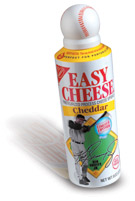

The advent of the seamless aluminum can brought big improvements in the package's delivery abilities 15 years ago. Still, lack of promotion and a kitschy image conspired to depress growth until Nabisco put some marketing muscle behind cheese in aerosol cans a few years ago. Sales took off, copackers jumped in to fill grocers' demands for private-label counterparts, and a packaging star was reborn.
Two barrier systems are available for food, though piston systems account for most of today's growth, according to Fred Spohr of CCL Container. The system relies on pneumatics: 130 psi of gas, typically nitrogen, are injected below a piston head, propelling a viscous food above out of the can when the top valve is depressed. More products are being packaged that way because "consumers are looking for convenience and marketers have to find a way to make their products stand out," says Spohr.
"The filling capacity for these types of containers has at least tripled in the last four years," adds Bernie Brooke of Bloomingdale, Ill.-based Terco Inc., one of a handful of manufacturers of aerosol filling equipment. Cheese fill speeds range from 60 to 300 cans a minute, he says.
Signature Brands LLC is one of the latest food processors to add piston-can filling capacity. Three years ago the Ocala, Fla., food and dessert decorating company began working with copackers to produce Betty Crocker icings in an aerosol can. This month, "we'll be moving packaging in house with our own line," reports Gary Stenzel, vice president of operations. "We know how to mix, transfer and fill cans without product separation, and we're working with our suppliers to get up to speed on gassing, plugging and crimping the containers."
Pillsbury tried a similar aerosol product in the mid-'80s, "but they were going after a much larger market," Stenzel says. The Betty Crocker branded version (General Mills owned Signature from 1970 until 1987) is more of a niche product, and sales suggest it's found its niche. "The seasoned decorating artist will continue to use our icing in a tube, but the no-mess, no-cleanup convenience of the can appeals to those of us who just want to get the job done," he says.
Signature isn't the only firm dabbling in new aerosol applications for food. Carmel, chocolate, fruit toppings and candy have been tried, with varying degrees of success, and a light butter is among the new applications debuting this year. Supermarkets have experimented with cream cheese for a couple of years, but the retail price is double that of an 8-oz. brick. "It's a great idea," believes Steven Fay, sales VP at Berner Foods Inc., "but packaging is probably 35 percent of the cost equation vs. 1 percent for a thin film wrapper." It also requires refrigeration.
Shelf-stable cheese is another matter, and Roscoe, Ill.-based Berner is riding a sales swell that has boosted the category above $94 million in recent years. Fay expects another 10 percent spike this year, thanks in part to growing grocer demand. Berner is setting the pace in run rates. With additional equipment and mechanical tweaking, Fay says Berner's rapid-flow, bottom-up fillers could churn out as many as 400 8-oz. cans a minute.
Delavan, Wis.-based Dairy Source added aerosol capacity in 1996. "We altered our cooking process two years ago to include European technology that eliminates any air pockets during the cooking process and in the filling," explains Tony Steinman, Dairy Source's president. Result: even product discharge and no unpleasant splattering when an air bubble reaches the valve.
"Like any one-supplier category, aerosol cheese was limping along until there was competition," Steinman reflects. "Now companies are doing more promotion, it's getting more facings, and consumers are more aware of the product."
Success breeds imitation, and low-price cheese sauces in aerosol cans are cropping up. Established players produce a cheese spread, which has a standard of identity. And industry-innovator Nabisco no longer makes its Easy Cheese line. Sister company Kraft has taken over production, though Nabisco continues to cross-promote it with its crackers.
Adding aerosol-filling capacity is a seven-figure investment decision, and a major food company would have to build any new categories before too many others jumped in. But trade accounts are beating a path to copackers' doors with new application ideas, making the outlook for food in aerosol cans bullish.